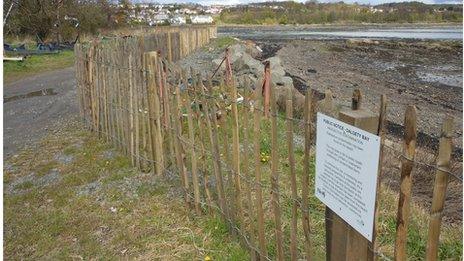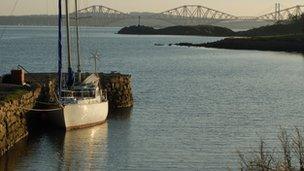Radioactive beach risk from wartime dump 'was ignored'
- Published

A stretch of beach at Dalgety Bay has been fenced off
The risk of radioactive contamination at a Scottish beach, which is only now being fully assessed, was reported to the government more than 50 years ago.
A confidential report from 1958, seen by the BBC, warned of the potential risks at sites where wartime aircraft had been dumped.
Radiation at the site at Dalgety Bay in Fife is believed to be from radium paint used on aircraft instruments.
Radiation was discovered at the beach by accident 20 years ago.
The Ministry of Defence is currently investigating how the radioactive pollution might be cleaned up, but has yet to accept liability.
In a statement it said that where liability for contaminated land is identified the ministry works to meet its portion of that liability.
It has been warned that part of the beach could be designated as the UK's first radioactive-contaminated land.
The Disposal of Radioactive Waste report, written in 1958, warned of "undesirably high levels of radiation" at sites where aircraft were broken down and stated that records should be kept and "handed on to future users of the land".
The 1958 report was written just a year before the MoD's base at Donibristle - now Dalgety Bay - was closed and later sold on for development.
For 20 years radioactive particles, thought to have been released by coastal erosion, have been found and removed from a stretch of beach.
Some of the most recent were described by the Scottish Environment Protection Agency (Sepa) as a "significant hazard to human health", capable of causing radiation burns and an increased risk of cancer if ingested.
The Health Protection Agency, however, says the chances of anyone encountering radioactive particles are small so the risks to human health are low.
Thousands of combat aircraft were 'bashed, burned and buried' after the Second World War at military sites around the country.
Instrument dials coated with radium paint so they would glow in the dark were among the waste buried and are believed to have caused the contamination at Dalgety Bay.
'Need for control'
The Ministry of Defence has long accepted its past activities are the most likely cause of the problem.
However, it argues that radium particles may have escaped from where they were buried due to the actions of developers.
The report - declassified and now in the National Archives - was obtained by Radio 4's investigative programme Face the Facts.
The document has an entire chapter dedicated to radium 226. It describes how private companies, which supplied radium for use in things like clocks and watches, were storing their radioactive waste in air raid shelters, petrol drums, even tea chests.

Only part of the Dalgety Bay coastline has been affected by the radioactive contamination
The report stressed the need for a national disposal service.
"There is little harm from the single watch or clock disposed of together with the house refuse, since it can be safely handled and the material is virtually insoluble," it said.
"But a different situation exists at premises where aircraft are broken down and the instruments are accumulated in heaps.
"We feel there may be need for control over the ultimate destination of these instruments since there may be undesirably high levels of radiation near these dumps."
Former Prime Minister Gordon Brown, the MP for the area, said the 50-year-old report showed clearly that "someone did know that there was a potential problem, and someone should have passed it on to the Ministry of Defence for them to take the appropriate action".
'Regular dialogue'
The Ministry of Defence said it would meet its statutory obligations and pay its portion of any liabilities over the contamination of Dalgety Bay, but only if it was "found to be a party responsible".
Andrew Robathan, Minister for Defence Personnel, Welfare and Veterans, added: "We recently published our final inspection plan with Sepa into Dalgety Bay.
"Working with Sepa, this represents a key milestone in understanding the situation at Dalgety Bay and presents the timetable for the investigation. I reaffirm our commitment to keeping the community informed."
Scottish Environment Secretary Richard Lochhead said: "The issues raised by this programme, together with the concerns of local residents, highlight the need for action - which local residents have been waiting decades for - to resolve the issue at Dalgety Bay.
"I have been in regular dialogue with the MoD on this issue and consistently calling for MoD to present remediation options as soon as possible."
<link> <caption>Face the Facts: Radioactive Legacy</caption> <url href="http://www.bbc.co.uk/programmes/b01gw1dp" platform="highweb"/> </link> is broadcast at 12:30 on Wednesday 2 May on BBC Radio 4. Listen online afterwards at the above link.
- Published31 January 2012
- Published26 October 2011
- Published31 October 2011